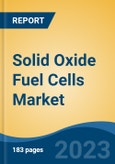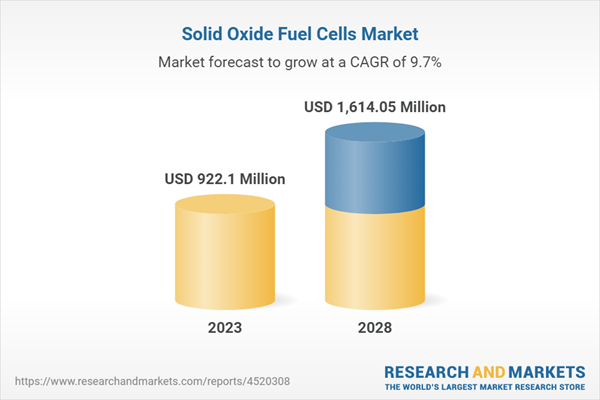Free Webex Call
The Global solid oxide fuel cells market is expected to thrive during the forecast period due to government investments to minimize dependency on fossil fuels. Speak directly to the analyst to clarify any post sales queries you may have.
10% Free customizationThis report comes with 10% free customization, enabling you to add data that meets your specific business needs.
A solid oxide fuel cell (or SOFC) is an electrochemical conversion device used in various industries that produces electricity directly from the oxidation of a fuel. Fuel cells are characterized by electrolyte material. SOFCs have solid oxide or ceramic electrolytes. SOFC systems and electrolyzers are an integral part of transforming energy systems toward sustainability. SOFCs convert fuel into electrical energy with efficiencies of up to 60% or more. Solid oxide electrolysis cells (SOECs) enable efficient storage of electrical energy and production of renewable synthetic fuels. Solid oxide cells operate at high temperatures and require advanced ceramic materials for their manufacture. The properties and quality of ceramic powders greatly affect the performance and durability of SOFC/SOEC cells and stacks. These devices integrate ceramics or solid metal oxides as electrolytes to conduct ions between the cathode and anode of the cell. Additionally, the system is designed to withstand high operating temperatures and work optimally with a variety of fuels such as hydrogen, natural gas, propane, and other clean fuels and mixtures. Additionally, the unit operates primarily on hydrogen, ensuring emission-free operations with heat and water vapor as the only by-products.
Advantages of this class of fuel cells include high combined thermal and power efficiency, long-term stability, fuel flexibility, low emissions, and relatively low cost. The main drawback is the high operating temperature. This results in longer start-up times and mechanical and chemical compatibility issues. There are many types of fuel cells, but they all share a common design and process.
An electrochemical reaction occurs between the negative electrode (anode) and the positive electrode (cathode) sandwiched between the electrolytes, generating an electric current. Electrolytes are ionic conductors that move ions from fuel to air or air to fuel to create a flow of electrons. Electrolytes differ between fuel cell types, and depending on the electrolyte used, fuel cells have slightly different electrochemical reactions, use different catalysts, operate on different fuels, and achieve different efficiencies. SOFC's electrolyte is unique. It is a solid ceramic material. The anode and cathode electrodes of Bloom's fuel cells are special proprietary inks that coat the electrolyte. Unlike other types of fuel cells, SOFCs do not require precious metals, corrosive acids, or molten materials to create. Ambient air enters the cathode side of the fuel cell as it heats up inside the energy server. Meanwhile, the steam mixes with fuel (natural gas or biogas) flowing from the anode side to produce reformate fuel. As the reformed fuel passes through the anode, it attracts oxygen ions from the cathode. Oxygen ions combine with the reformed fuel to produce electricity, steam, and carbon dioxide.
Increase in Data Centers will Drive the Global Solid Oxide Fuel Cells Market
Data centers are becoming a vital part of today's digital technology-driven world. Many industries rely on data centers, from cloud computing to telecommunications to finance. Providing these services 24/7 requires a lot of energy. According to Data Center Knowledge, 2% of America’s total energy consumption is spent in these data centers, which can cost thousands of dollars each time a data center goes down. To stay online, data centers rely on primary and backup power. The demand for communication and computing power has created an opportunity for fuel cells. Fuel cells, alone or in combination with other technologies, can offer outstanding reliability. Installing fuel cells can generate electricity at a lower cost than grid power. Clean, reliable, and scalable, fuel cells are an attractive option for data centers to meet their energy demands and sustainability goals. Fuel cells are in line with the move to reduce the environmental impact of data centers. They go from low to zero emissions depending on the fuel source. Data centers require continuous and reliable power delivery. A comprehensive backup power plan that includes fuel cells and other power sources can provide the 99.9999% availability data center needs. Achieving 99.9999% uptime means 31.5 seconds or less of downtime per year. This has led companies to consider fuel cells in their data centers. Fuel cell prices are becoming increasingly affordable. This creates a competitive advantage over power grids and backup generators. Rather than sitting idle most of the time like diesel generators, hydrogen-powered infrastructure has real potential beyond providing backup power. As an example, when eBay opened their data center in Salt Lake City, Utah in 2013, they used 6-megawatt Energy fuel cells as the primary power source for the facility, with the grid only used as a backup. In 2015, eBay added another 3.75 MW of Bloom Fuel Cells, bringing the total to 9.75 MW. With a fuel cell system, eBay has eliminated the need for large backup generators.Latest projects fueling the growth of the global solid oxide fuel cells market
- In 2020, the US Department of Energy (DOE) selected 12 projects to receive approximately USD34 million in federal funding under the Financing Opportunity Announcement (FOA), Small Scale Solid Oxide Fuel Cell Systems, and Hybrid Electrolyser Technology Development. This research effort is part of DOE's Office of Fossil Energy (FE)'s SOFC program to enable the generation of highly efficient, low-cost electricity from coal and natural gas with near-zero emissions to the atmosphere. The selected projects pursue a common goal of ensuring efficient and reliable power grids while protecting the environment
- In 2021, Philips announced a USD3 million grant from the US Department of Energy to advance the development of high-performance reversible solid oxide fuel cells. Phillips is working with the Georgia Institute of Technology (Georgia Tech) to demonstrate the commercial feasibility of a low-cost, high-efficiency reversible solid oxide fuel cell (RSOFC) system for hydrogen and power generation. The technology is one of many that Philips is pursuing as part of its commitment to a sustainable, low-carbon energy future.
- Elcogen AS, a European manufacturer of clean energy technologies providing affordable green hydrogen and zero-emission electricity, with approximately USD24 million from HydrogenOne Capital Growth plc announces the completion of the investment to expand the capacity to enable the production of green hydrogen using reversible solid oxide cell technology. This is intended to help finance the expansion of Elcogen's facility in Tallinn to create a new automated solid oxide fuel cell production line. It will initially expand to 25 MW/year, increasing to 50 MW/year (equivalent to 100-200 MW for electrolysis). mode); which will allow the company to continue to invest in research and development to further advance its solid oxide technology and fuel cells.
- In 2020, Cummins Inc. announced that it had received two federal grants totaling USD4.6 million to advance the commercialization of its solid oxide fuel cell (SOFC) technology. A US Department of Energy (DOE) grant will fund two of his projects that demonstrate the potential of SOFCs. An investment of USD2.6 million DOE grant will help Cummins build a small 20-kilowatt (kW) SOFC power system at the University of Connecticut that can run on natural gas but can use multiple fuels as it runs for 5,000 hours to demonstrate durability.
Market Segmentation
The global solid oxide fuel cells market is segmented based on type, application, end user, and region. Based on type, the market is bifurcated into planar and tubular. Based on application, the market is further bifurcated into stationary, transportation, and portable. Based on end user, the market is bifurcated into commercial, data centers, military & defense, and others. Based on region, the market is further bifurcated into North America, Asia-Pacific, Europe, South America, and Middle East & Africa.Market player
Major market players in the global solid oxide fuel cells market are Bloom Energy Corporation, H2E Power Systems Inc., Watt Fuel Cell Corporation, Ceres Power Holdings PLC, Elcogen AS, Sunfire GmbH, Mitsubishi Heavy Industries, Ltd., Ceres Power Holdings PLC, LG Fuel Cell Systems Inc., and Doosan Fuel Cell Co., Ltd.Report Scope:
In this report, the global solid oxide fuel cells market has been segmented into the following categories, in addition to the industry trends which have also been detailed below:Solid Oxide Fuel Cells Market, By Type:
- Planar
- Tubular
Solid Oxide Fuel Cells Market, By Application:
- Stationary
- Transportation
- Portable
Solid Oxide Fuel Cells Market, By End-User:
- Commercial
- Data Centers
- Military & Defense
- Others
Solid Oxide Fuel Cells Market, By Region:
- North America
- United States
- Canada
- Mexico
- Asia-Pacific
- China
- India
- Japan
- South Korea
- Australia
- Europe
- Germany
- United Kingdom
- France
- Spain
- Italy
- South America
- Brazil
- Argentina
- Colombia
- Middle East
- Saudi Arabia
- South Africa
- UAE
Competitive Landscape
Company Profiles: Detailed analysis of the major companies present in the global solid oxide fuel cells market.Available Customizations:
With the given market data, the publisher offers customizations according to a company's specific needs.This product will be delivered within 1-3 business days.
Table of Contents
1. Product Overview
2. Research Methodology
5. Global Solid Oxide Fuel Cells Market Outlook
6. North America Solid Oxide Fuel Cells Market Outlook
7. Asia-Pacific Solid Oxide Fuel Cells Market Outlook
8. Europe Solid Oxide Fuel Cells Market Outlook
9. South America Solid Oxide Fuel Cells Market Outlook
10. Middle East & Africa Solid Oxide Fuel Cells Market Outlook
11. Market Dynamics
13. Company Profiles
15. About the Publisher & Disclaimer
Companies Mentioned (Partial List)
A selection of companies mentioned in this report includes, but is not limited to:
- Bloom Energy Corporation
- H2E Power Systems Inc.
- Watt Fuel Cell Corporation
- Ceres Power Holdings PLC
- Elcogen AS
- Sunfire GmbH
- Mitsubishi Heavy Industries, Ltd.
- Ceres Power Holdings PLC
- LG Fuel Cell Systems Inc.
- Doosan Fuel Cell Co., Ltd
Table Information
| Report Attribute | Details |
|---|---|
| No. of Pages | 183 |
| Published | October 2023 |
| Forecast Period | 2023 - 2028 |
| Estimated Market Value ( USD | $ 922.1 Million |
| Forecasted Market Value ( USD | $ 1614.05 Million |
| Compound Annual Growth Rate | 9.7% |
| Regions Covered | Global |









